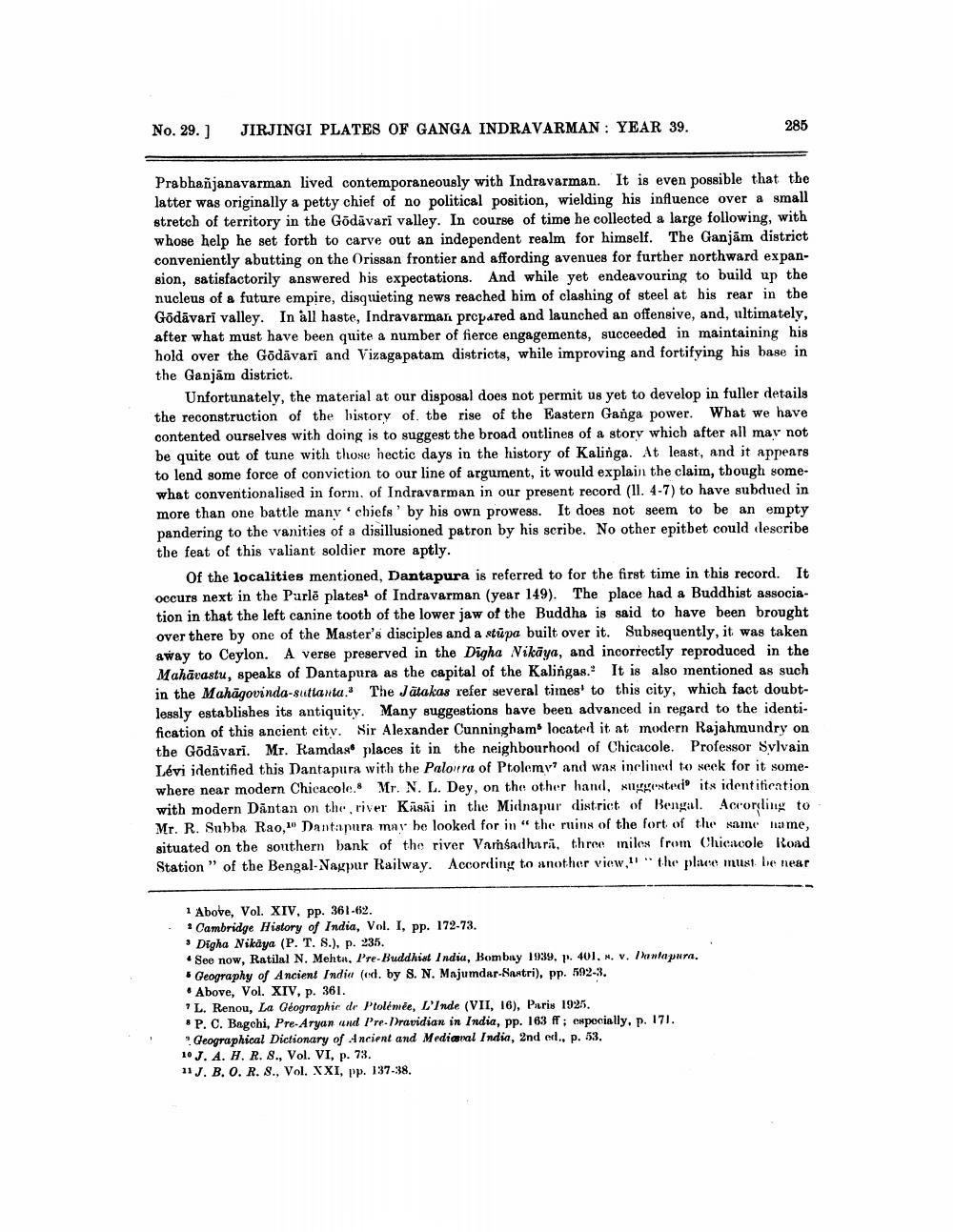________________
No. 29.)
JIRJINGI PLATES OF GANGA INDRAVARMAN : YEAR 39.
285
Prabhañjanavarman lived contemporaneously with Indravarman. It is even possible that the latter was originally a petty chief of no political position, wielding his influence over a small stretch of territory in the Godavari valley. In course of time he collected a large following, with whose help he set forth to carve out an independent realm for himself. The Ganjam district conveniently abutting on the Orissan frontier and affording avenues for further northward expansion, satisfactorily answered his expectations. And while yet endeavouring to build up the nucleus of a future empire, disquieting news reached bim of clashing of steel at his rear in the Gödāvari valley. In all haste, Indravarman prepared and launched an offensive, and, ultimately, after what must have been quite a number of fierce engagements, succeeded in maintaining his hold over the Godāvari and Vizagapatam districts, while improving and fortifying his base in the Ganjām district.
Unfortunately, the material at our disposal does not permit us yet to develop in fuller details the reconstruction of the history of. tbe rise of the Eastern Ganga power. What we have contented ourselves with doing is to suggest the broad outlines of a story which after all may not be quite out of tune with those hectic days in the history of Kalinga. At least, and it appears to lend some force of conviction to our line of argument, it would explain the claim, though somewhat conventionalised in form. of Indravarman in our present record (11. 4-7) to have subdued in more than one battle many chiefs' by his own prowess. It does not seem to be an empty pandering to the vanities of a disillusioned patron by his scribe. No other epitbet could clescribe the feat of this valiant soldier more aptly.
Of the localities mentioned, Dantapura is referred to for the first time in this record. It occurs next in the Purlē plates of Indravarman (year 149). The place had a Buddhist association in that the left canine tooth of the lower jaw of the Buddha is said to have been brought over there by one of the Master's disciples and a stūpa built over it. Subsequently, it was taken away to Ceylon. A verse preserved in the Digha Nikāya, and incorrectly reproduced in the Mahārastu, speaks of Dantapura as the capital of the Kalingas. It is also mentioned as such in the Mahāgovinda-suttanta, The Jätakas refer several times to this city, which fact doubtlessly establishes its antiquity. Many suggestions bave been advanced in regard to the identification of this ancient city. Sir Alexander Cunningham located it at modern Rajahmundry on the Gödāvari. Mr. Ramdas places it in the neighbourhood of Chicacole. Professor Sylvain Lévi identified this Dantapura with the Palora of Ptolemy' and was inclined to seek for it somewhere near modern Chicacole & Mr. N. L. Dey, on the other hand, suggested its identification with modern Däntan on the river Kaski in the Midnapur district of Bengal. Accorcling to Mr. R. Subba Rao, Dantapura may he looked for in " the ruins of the fort of the same name, situated on the southern bank of the river Vamsadhari, three miles from Chicacole Road Station of the Bengal-Nagpur Railway. According to another view," the place must be near
1 Above, Vol. XIV. pp. 361-62. . Cambridge History of India, Vol. I, pp. 172-73. • Digha Nikaya (P. T. 8.), p. 235. • See now, Ratilal N. Mehta, Pre-Buddhist India, Bombay 1939. p. 401. N. v. Bentapura. . Geography of Ancient India (ed. by S. N. Majumdar-Santri), pp. 592-3. • Above, Vol. XIV, p. 361.
L. Renou, La Géographic de Ptolemée, L'Inde (VII, 16), Paris 1925. .P. C. Bagchi, Pre-Aryan und Pre-Dravidian in India, pp. 163 ff; especially, p. 17).
Geographical Dictionary of Ancient and Medienal India, 2nd ed., p. 53. 10 J. A. H. R. S., Vol. VI, p. 73. 11 J. B.O.R.S., Vol. XXI, pp. 137-38.




